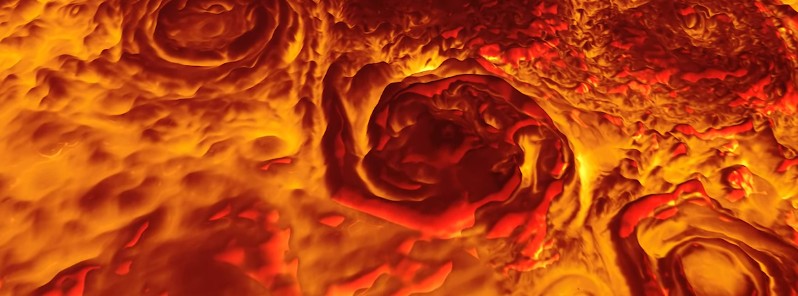3D infrared animation of Jupiter’s north pole

NASA's Juno scientists have unveiled their 3D infrared movie depicting densely packed cyclones and anticyclones that permeate Jupiter’s polar regions, and the first detailed view of a dynamo, or engine, powering the magnetic field for any planet beyond Earth.
The 3D fly-around of Jupiter's north pole was generated using data collected by the spacecraft’s Jovian InfraRed Auroral Mapper (JIRAM) instrument which captures light emerging from deep inside Jupiter equally well, night or day.
The instrument probes the weather layer down to 50 to 70 km (30 to 45 miles) below Jupiter's cloud tops. The imagery will help the team understand the forces at work in the animation – a north pole dominated by a central cyclone surrounded by eight circumpolar cyclones with diameters ranging from 4 000 to 4 600 km (2 500 to 2 900 miles).
"Before Juno, we could only guess what Jupiter’s poles would look like," said Alberto Adriani, Juno co-investigator. "Now, with Juno flying over the poles at a close distance it permits the collection of infrared imagery on Jupiter’s polar weather patterns and its massive cyclones in unprecedented spatial resolution."



Juno's deputy-principal investigator Jack Connerney and colleagues also produced new magnetic field model from measurements made during eight orbits of Jupiter.
From those, they derived maps of the magnetic field at the surface and in the region below the surface where the dynamo is thought to originate. Because Jupiter is a gas giant, "surface" is defined as one Jupiter radius, which is about 71 450 km (44 400 miles).
These maps provide an extraordinary advancement in current knowledge and will guide the science team in planning the spacecraft’s remaining observations.
"We’re finding that Jupiter’s magnetic field is unlike anything previously imagined," Connerney said. "Juno’s investigations of the magnetic environment at Jupiter represent the beginning of a new era in the studies of planetary dynamos."
The map Connerney’s team made of the dynamo source region revealed unexpected irregularities, regions of surprising magnetic field intensity, and that Jupiter’s magnetic field is more complex in the northern hemisphere than in the southern hemisphere.
About halfway between the equator and the north pole lies an area where the magnetic field is intense and positive. It is flanked by areas that are less intense and negative. In the southern hemisphere, however, the magnetic field is consistently negative, becoming more and more intense from the equator to the pole.


The researchers are still figuring out why they would see these differences in a rotating planet that’s generally thought of as more-or-less fluid.
"Juno is only about one third the way through its planned mapping mission and already we are beginning to discover hints on how Jupiter’s dynamo works," said Connerney.
The spacecraft has logged nearly 200 million km (122 million miles) to complete those 11 science passes since entering Jupiter's orbit on July 4, 2016.
Its 12th science pass will take place on May 24.
Featured image:

Commenting rules and guidelines
We value the thoughts and opinions of our readers and welcome healthy discussions on our website. In order to maintain a respectful and positive community, we ask that all commenters follow these rules.